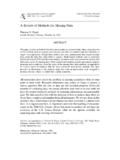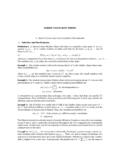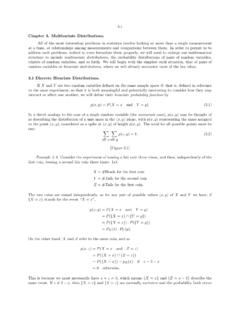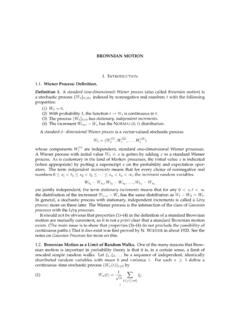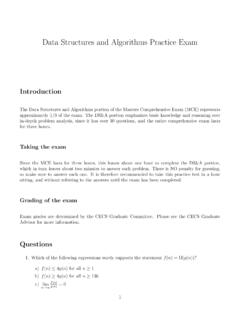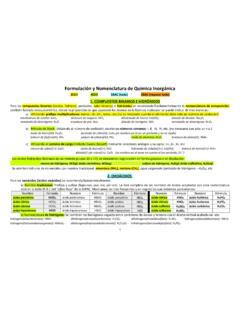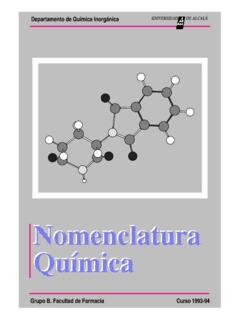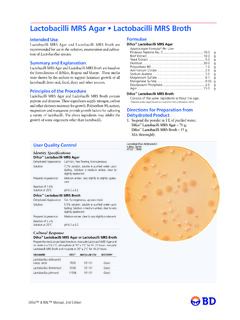Transcription of LECTURE 10: CHANGE OF MEASURE AND THE GIRSANOV …
1 LECTURE 10: CHANGE OF MEASURE AND THE GIRSANOV Cameron-Martin theorem, which has figured prominently in the developments of the lastseveral lectures, is the most important special case of the far more generalGirsanov theorem, whichis our next topic of discussion. Like the Cameron-Martin theorem, the GIRSANOV theorem relates theWiener measurePto different probability measuresQon the space of continuous paths by giving anexplicit formula for the likelihood ratios between them. But whereas the Cameron-Martin theoremdeals only with very special probability measures, namely those under which paths are distributedas Brownian motion with (constant) drift, the GIRSANOV theorem applies to nearly all probabilitymeasuresQsuch thatPandQare mutually absolutely MartingalesLet{Wt}0 t< be a standard Brownian motion under the probability measureP, and let(Ft)0 t< be the associated Brownian filtration.
2 Recall that underP, for any scalar R,the processZ (t) = exp{ Wt 2t/2}is a martingale with respect to (Ft)0 t< . These mar-tingales provide the likelihood ratios used to build the probability measuresP described in theCameron-Martin martingalesZ (t) are instances of a much larger class of exponential martingales defined asfollows. Let{ s}be an adapted, locally-H2process (recall that this means that, for everyt 0,the truncated process{ s1{s t}}is in the classH2). Thus, the It o integrals t0 sdWsare allwell defined. Define(1)Z(t) = exp{ t0 sdWs 12 t0 2sds}Theorem 1.(Novikov) If for eacht 0,(2)Eexp{ t0 2sds/2}< then for eacht 0,(3)EZ(t) = this is the case then the process{Z(t)}t 0is a positive shall only prove this in the special case where the process sis is deterministic (nonrandom)and continuous the function tis nonrandom, the random variable t0 sdWsis normallydistributed with mean 0 and variance t0 , for anys<t, the random variable1 This was a homework problem in an earlier ts udWuis normally distributedandindependent of the algebraFs.
3 Consequently, for anys<t,E(exp{ t0 udWu} Fs)= exp{ s0 udWu}E(exp{ ts udWu} Fs)= exp{ s0 udWu}Eexp{ ts udWu}= exp{ s0 udWu}exp{ ts 2udu/2}.(Here we have used the elementary property of the normal distribution that, ifX Normal(0, 2),thenEeX=e 2/2.) It follows from this that the processZ(t) is a martingale relative to thefiltration (Ft)0 t< , and that the equation (3) is valid for allt< .Second shall apply the It o formula . Setf(x,t) = exp{x 12 t0 2sds}andYt= t0 sdWs;thenZ(t) =f(Yt,t).The processYtis an It o process, as it is defined by a stochastic integral, and so the It o formulaapplies:dZ(t) =ft(Yt,t)dt+ (1/2)fxx(Yt,t)d Y,Y t+fx(Yt,t)dYt= (1/2) 2tZ(t)dt+ (1/2)Z(t)d Y,Y t+Z(t)dYt= (1/2) 2tZ(t)dt+ (1/2)Z(t) 2tdt+Z(t) tdWt=Z(t) implies that(4)Z(t) = t0Z(s) follows thatZ(t) is anL2martingale,providedthat for eachT< the processZ(t)1{t T}is in the classH2.
4 This is easily checked (Exercise!) when the integrand sis nonrandom andcontinuous, using (for instance) the fact thatYthas a normal GIRSANOV TheoremLet{ t}be an adapted process satisfying the hypotheses of Novikov s Proposition, and letZ(t)be defined by (1). By relation (3), for eachT>0 the random variableZ(T) is a likelihood ratio:that is, the formula (5)Q(F) =EP(Z(T)1F)defines a new probability MEASURE on ( ,F). GIRSANOV s theorem describes the distribution of thestochastic process{W(t)}t 0under this new probability MEASURE . Define(6) W(t) =W(t) t0 sdsTheorem 2.( GIRSANOV ) Under the probability measureQ, the stochastic process{ W(t)}0 t Tisa standard Wiener encompasses as a special case the Cameron Martin Theorem proved earlier. Its uses inmathematical finance theory go far beyond the (relatively) simple calculations of the sort we didin pricing barrier options earlier.
5 To provide a succinct example, we shall next revisit the problemof option pricing in foreign exchange, but under a more general model for exchange rates. In thenext LECTURE , we shall give a more substantial application to the pricing of derivative securities inmulti-factormodels, including the derivatives known proof of GIRSANOV s theorem is given in the Exchange RevisitedIn the previous LECTURE , we considered perhaps the simplest model of foreign exchange, in whichthe exchange rate between currencies (for definiteness, the U. S. dollar and the British poundsterling) follows a geometric Brownian motion with constant drift, and the riskless assets in eachof the two currencies have constant (but not necessarily equal) rates of return. These assumptionsare not always realistic, especially in problems involving contracts with maturities longer than afew months.
6 Here, we shall investigate a more general model, in which the rates of return on theriskless assets and the volatility of the exchange rate process are time-varying, but , it is assumed that the exchange rateYt(defined to be the number of British pounds thatone dollar will buy at timet) obeys a stochastic differential equation of the form(7)dYt= tYtdt+ tYtdWt,where both the drift tand the volatility tare continuous but nonrandom functions oft. Fur-thermore, the riskless assetsUS MoneyMarketandUK Money Marketfor dollar and pound-sterling investors, reported in units of dollars and British pounds, respectively, have share pricesAtandBtthat satisfy the ordinary differential equationsdAt=rA(t)Atdtand(8)dBt=rB(t) solutions to these differential equations areAt=A0exp{ t0rA(s)ds}and(9)Bt=B0exp{ t0rB(s)ds}.
7 By It o s formula , the solution2to the stochastic differential equation (7) is(10)Yt=Y0exp{ t0( s 2s/2)ds+ t0 sdWs}.Proposition a risk-neutral probability MEASURE for the pound-sterling investor. Ifthe dollar/pound sterling exchange rate obeys a stochastic differential equation of the form (7), and2 Actually, It o s formula only shows that (10) isasolution to the stochastic differential equation (7). Later in thecourse we shall see that, for stochastic differential equations such as (7), if the coefficients tand tare sufficientlywell-behaved, then solutions are the riskless rates of return for dollar investors and pound-sterling investors arerA(t)andrB(t),respectively, then underQBit must be the case that(11) t=rB(t) rA(t),and so the exchange rateYtis given by(12)YtY0= exp{ t0(rB(s) rA(s) 2s/2)ds+ t0 sdWs},where under the measureQBthe processWtis a standard Brownian proof is essentially the same as in the case of constant coefficients ( LECTURE 9).
8 The assetUS MoneyMarketis tradeable, so its discounted value in pounds sterling must be a martingaleunder the risk-neutral measureQB. The discounted value at timetisAtYt/Bt, which, by equations(9) and (10) isAtYt/Bt=Y0exp{ t0( s+rA(s) rB(s) 2s/2)ds+ t0 sdWs}.It is easily checked that this is a martingale only if equation (11) holds. Proposition a risk-neutral probability MEASURE for dollar investors. Then the mea-suresQAandQBare mutually absolutely continuous, and the likelihood ratio on the algebraFTof events observable by timeTis(13)(dQAdQB)FT= exp{ T0 tdWt 12 T0 2tdt}. proof is virtually the same as in the case of constant coefficients, and is thereforeomitted. The likelihood ratio (13) is an instance of the GIRSANOV likelihood ratio, and so the GIRSANOV the-orem applies.
9 In particular, it follows that, under the risk-neutral measureQAfor dollar investors,the processWtthat drives the exchange rate, which underQBis a standard Wiener process, is aWiener process with instantaneous drift tdt. Equivalently, the process(14) Wt:=Wt+ t0 sdsis, underQA, a standard Brownian Continuity and Events of Probability ZeroLemma mutually absolutely continuous probability measures on a MEASURE space( ,F), that is, there is a positive random variableY(=dQ/dP)such that for every eventF F,Q(F) =EP(Y1F)and(15)P(F) =EQ(Y 11F).(16)Then for any eventF F,(17)P(F) = 0 Q(F) = is a standard theorem of MEASURE theory that ifXis a random variable that isP almostsurely zero (that is,P{X= 0}= 1) thenXisP integrable andE|X|=EX= 0. IfF Fisan event such thatP(F) = 0, then the random variableY1 FisP almost surely zero, becauseit assumes the value 0 everywhere on the complement ofF, which is an event ofP probabilityone.
10 Consequently, this random variable hasEP expectation zero, which by (15) implies thatQ(F) = 0. The converse follows by reversing the roles ofPandQ. It is somewhat remarkable that the converse is also true: IfPandQare probability measureson a common MEASURE space ( ,F) such that the set of events withP probability zero coincideswith the set of events withQ probability zero, thenPandQare mutually absolutely is (essentially) the fundamentally importantRadon-Nikodymtheorem of MEASURE 1 is of interest here because it has important ramifications in finance, some of which wenow discuss. Suppose that{P } Ris a one-parameter family of probability measures on a commonprobability space such that, underP , the processWtis a Brownian motion with drift.


